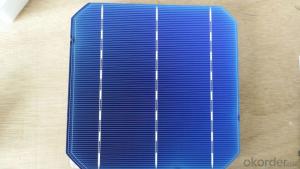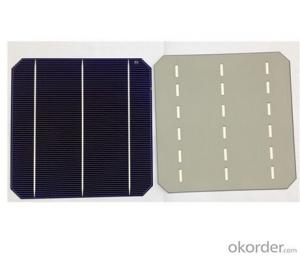Solar Cells for Dummies:156x156mm 3bb Mono Solar Cells 6x6 with Superior Quality
- Loading Port:
- China main port
- Payment Terms:
- TT OR LC
- Min Order Qty:
- 100 watt
- Supply Capability:
- 500000 watt/month
OKorder Service Pledge
OKorder Financial Service
You Might Also Like
Specification
156x156mm 3BB Mono Solar Cells 6x6 with Sperior Quality
Feature
1.High conversion efficiencies resulting in superior power output performance.
2.Outstanding power output even in low light or high temperature conditions
3.Optimized design for ease of soldering and lamination
4.Long-term stability,reliability and performance
5.Low breakage rate
6. Output power tolerance of +/-3%

Physical characteristic
Dimension: 156*156mm±0.5mm
Thickness: wafer(Si):200μm±20μm
Cell:240μm±40μm
Front: silver bus bars;dark blue/others silicon nitride anti reflection coating
Back: silver/aluminum bus bars;full-surface aluminum BSF
Warranty
25-years limited warranty on power output: 10 years/90%, 25 years/80%
Packaging
The solar cells are packed in cartons, and then pallet.
Shipping by sea or by air are both ok, it's up to customer’s choice.
We’d like to inquire the freight cost for customer after be informed exact quantity and destination address
- Q: Does the solar cell generate electricity in the absence of the sun, only in the case of strong lights or lasers? If you can achieve how much, and the same day?
- One of the directions for the development of modern solar cells is to maximize the frequency range of the light waves that can be energized (to the low frequency direction) to increase the power generation efficiency of solar cells
- Q: Can solar cells be used in public infrastructure projects?
- Yes, solar cells can be used in public infrastructure projects. Solar cells can be integrated into various infrastructure elements such as street lights, bus stops, parking meters, and even road surfaces to generate electricity from sunlight. This sustainable energy source can help reduce reliance on traditional power grids, lower carbon emissions, and promote renewable energy use in public spaces.
- Q: Are there any health risks associated with solar cells?
- There are no direct health risks associated with solar cells themselves. However, the manufacturing and disposal processes of solar panels can have some environmental impacts and potential health risks if not managed properly.
- Q: What is the pollution of solar cells?
- dry batteries and alkaline batteries to dry batteries and batteries, for example, to study its composition. We use spare time to open a piece of carbon zinc battery and found that the surface is made of zinc cylinder (according to the information that, in order to increase the toughness of zinc sheet strength, slow down the corrosion of zinc film to extend battery life, In the addition of aluminum,
- Q: How are solar cells connected to the electrical grid?
- Solar cells are connected to the electrical grid through the use of inverters, which convert the direct current (DC) produced by the solar panels into alternating current (AC) that can be used by homes and businesses. This AC power is then fed into the electrical grid, allowing for the distribution of solar energy to other users and ensuring a reliable supply of electricity.
- Q: Can solar cells be used in powering remote monitoring systems?
- Yes, solar cells can be used in powering remote monitoring systems. Solar cells convert sunlight into electricity, making them a sustainable and reliable source of power for remote locations. They can be used to charge batteries that store the energy for continuous operation of monitoring systems, ensuring uninterrupted monitoring even in remote areas with limited access to the power grid.
- Q: What's the benefit of using a solar cell?
- It can help avoid the greenhouse effect.
- Q: Can solar cells be used for powering offshore oil rigs?
- Yes, solar cells can be used for powering offshore oil rigs. They can provide a renewable and clean energy source to supplement or replace traditional fossil fuel-based generators, reducing the environmental impact and operational costs of offshore oil operations.
- Q: Can solar cells be used in swimming pool heating?
- Yes, solar cells can be used in swimming pool heating. By capturing sunlight and converting it into electricity, solar cells can power a pool heating system, providing an eco-friendly and cost-effective way to warm up the pool water.
- Q: Can solar cells be used in farming or agriculture?
- Yes, solar cells can be used in farming or agriculture. They can be used to power various agricultural processes such as irrigation systems, lighting, and machinery. Additionally, solar panels can be installed on rooftops or in fields to generate electricity, reducing reliance on the grid and providing a sustainable energy source for farming operations.
Send your message to us
Solar Cells for Dummies:156x156mm 3bb Mono Solar Cells 6x6 with Superior Quality
- Loading Port:
- China main port
- Payment Terms:
- TT OR LC
- Min Order Qty:
- 100 watt
- Supply Capability:
- 500000 watt/month
OKorder Service Pledge
OKorder Financial Service
Similar products
Hot products
Hot Searches
Related keywords






























